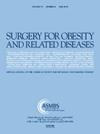Robotic sleeve gastrectomy has higher complication rates compared to laparoscopic: 8-year analysis of robotic versus laparoscopic primary bariatric surgery
IF 3.5
3区 医学
Q1 SURGERY
引用次数: 0
Abstract
Background
Robotic-assisted bariatric surgery is growing rapidly. The optimal approach to minimize complications remains unclear.
Objective
Assess robot utilization and compare 30-day outcomes for laparoscopic and robotic primary sleeve gastrectomy (SG) and Roux-en-Y gastric bypass (RYGB) using the Metabolic and Bariatric Surgery Accreditation and Quality Improvement Program (MBSAQIP) database.
Setting
United States.
Methods
A retrospective analysis of the MBSAQIP database identified primary SG and RYGB cases from 2015 to 2022. Revisions/conversions, cases converted to another approach, and combined cases other than esophagogastroduodenoscopy were excluded. Outcomes were compared with logistic regression following 1:1 propensity-score matching to adjust for differences in patient demographics/comorbidities and operative variables.
Results
A total of 823,902 cases (591,118 SG; 232,784 RYGB) were included. From 2015 to 2022, the percentage of SG and RYGB performed robotically increased from 6.7% and 6.9% to 29.5% and 31.8%, respectively. Compared to laparoscopic, robotic SG had significantly higher overall morbidity (odds ratio 1.14 [1.07-1.21], P < .001), leak (1.24 [1.05-1.46], P = .03), and bleeding rates (1.34 [1.13-1.58], P < .001). Robotic RYGB had significantly lower overall morbidity (.75 [.70-.81], P < .001) and bleeding (.80 [.68-.94], P < .01) with similar leak rates (.87 [.71-1.07], P = .18). Combined robotic SG and RYGB outcomes were similar to laparoscopic for 2020-2022 cases, except for higher rates of organ/space infection, readmission, and septic shock in the robotic group.
Conclusion
Robotic SG has higher complication rates compared to laparoscopic, while robotic RYGB is protective against bleeding complications. Short-term outcomes for robotic surgery have become more similar to laparoscopic, but remain inferior. Further studies are warranted to elucidate the factors driving these findings.
与腹腔镜相比,机器人袖带胃切除术的并发症发生率更高:机器人与腹腔镜初级减肥手术的8年分析。
背景:机器人辅助减肥手术正在迅速发展。减少并发症的最佳方法尚不清楚。目的:利用代谢和减肥手术认证和质量改进计划(MBSAQIP)数据库评估机器人的使用情况,并比较腹腔镜和机器人初级袖式胃切除术(SG)和Roux-en-Y胃旁路术(RYGB)的30天疗效。背景:美国。方法:回顾性分析MBSAQIP数据库,确定2015年至2022年原发性SG和RYGB病例。排除修正/转换,转换为其他入路的病例,以及除食管胃十二指肠镜检查外的联合病例。结果采用1:1倾向评分匹配的逻辑回归进行比较,以调整患者人口统计学/合并症和手术变量的差异。结果:共823902例(591118例;232,784 RYGB)。从2015年到2022年,机器人完成的SG和RYGB的比例分别从6.7%和6.9%增加到29.5%和31.8%。与腹腔镜相比,机器人SG的总发病率(优势比1.14 [1.07-1.21],P < .001)、漏出(优势比1.24 [1.05-1.46],P = .03)和出血率(优势比1.34 [1.13-1.58],P < .001)显著高于腹腔镜。机器人RYGB的总体发病率显著降低。- 75 .70美元。[81], P < 0.001)和出血(P < 0.001)。80 .68点-。[94], P < 0.01),泄漏率相似(。[.71-1.07], p = .18)。在2020-2022年的病例中,联合机器人SG和RYGB的结果与腹腔镜相似,除了机器人组的器官/空间感染、再入院率和感染性休克率更高。结论:与腹腔镜手术相比,机器人SG的并发症发生率更高,而机器人RYGB对出血并发症有保护作用。机器人手术的短期效果已经越来越接近腹腔镜手术,但仍然较差。需要进一步的研究来阐明导致这些发现的因素。
本文章由计算机程序翻译,如有差异,请以英文原文为准。
求助全文
约1分钟内获得全文
求助全文
来源期刊
CiteScore
6.70
自引率
12.90%
发文量
570
审稿时长
56 days
期刊介绍:
Surgery for Obesity and Related Diseases (SOARD), The Official Journal of the American Society for Metabolic and Bariatric Surgery (ASMBS) and the Brazilian Society for Bariatric Surgery, is an international journal devoted to the publication of peer-reviewed manuscripts of the highest quality with objective data regarding techniques for the treatment of severe obesity. Articles document the effects of surgically induced weight loss on obesity physiological, psychiatric and social co-morbidities.

 求助内容:
求助内容: 应助结果提醒方式:
应助结果提醒方式:


